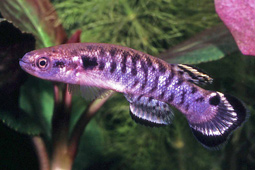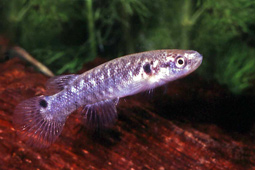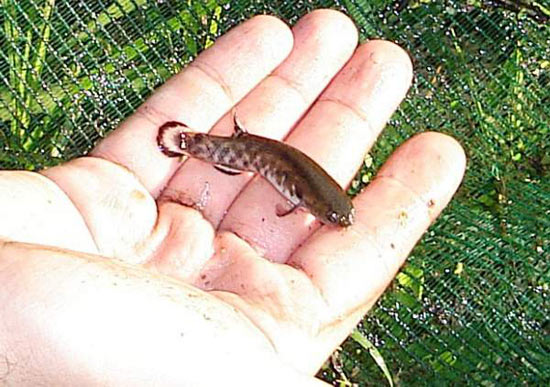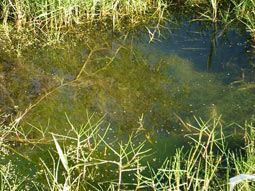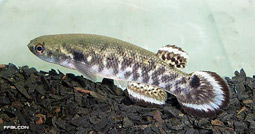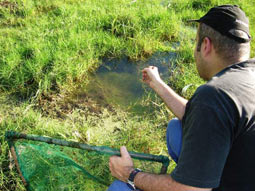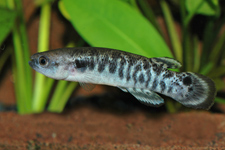History
After Hrbek & Larson (1999) Kryptolebias caudomarginatus (former Rivulus caudomarginatus) is to be seen as one of the most primitive neotropical Rivuline fishes. Not only by external characters but also by moleculair genes.
In 2011 Costa declares the name K. caudomarginatus to be a synonyme to K. ocellatus. By this the name K. caudomarginatus is not valid anymore. In the same paper Costa describes the fish we did know till then as Kryptolebias ocellatus as Kryptolebias hermaphrodites.
Quote: Kryptolebias Costa is a genus of rivulid killifishes, comprising both freshwater species inhabiting shallow streams of Surinam and south-eastern Brazil (Costa, 2004; Vermeulen & Hrbek, 2005), and species uniquely found in estuarine habitats, usually mangrove swamps, between southeastern United States of America and southern Brazil (Costa, 2006a, 2008). The latter group of species constitutes a well corroborated clade, hereafter termed the K. marmoratus species group, which is diagnosed by the presence of a long anterior nostril, its tip extending beyond the anterior profile of the head (vs. short, not extending beyond the anterior profile of the head), numerous scales in the longitudinal series (44-48, vs. 30-40), End Quote.
The species differs from K. marmoratus the circumcaudal black border and white sub- border in males. The overall melanism on the body and high LL- scalescounts are other data that seperates this species from its congerers. They also seem to reproduce as oviparious hermaphrodites but this is not confirmed by scientists and hobbyists that have other expirience in this.
Habitats are mostly semi marine waters along the coast of Brasil between Santa Rio de Janeiro, Santa Catharina and Sao Paulo.
Together with K. ocellatus other Cyprinodont fishes can be present. So lives Rivulus hermaphroditus in pure marine or brackish waters and Rivulus santensis (or Janeiroensis.) if waters are not to salty.
The species prefers the inland swamps and stagnant pools that are brackish or full marine of origen. They do not live in the mangroves were K. hermaphrodites use to live.
Reproduction
Breeding Kryptolebias ocellatus is not very difficult. Their eggs are rather big ( 2 mm ) and develop in 2 - 3 weeks. As the species does not live in pure marine water only and use to live in freshwater to it is possible to keep and breed it in freshwater. It is however wise to ad some salt to the aquariumwater (1.010 - 1.015) and keep the pH above the neutral level. Tempertures may vary between 20 and 30 C.
Sunlight or sufficient artificial light during the day is appreciated by these fish.
Juveniles are eating artemia from the first day on and take after 3 to 4 weeks also bigger life food like white worms and daphnia. Diet should be of high proteine values. It is wise also to add some salt to the tanks with the juviniles. Flake food is taken to but will be ignored if fresh life- or frozen lifefood is offered. In 5 to 7 months the fishes will grow to maturity.
The reported lifespan in captivity is 3 years. Dispite the large eggs the species can be very productive during their whole life..
Variations
Map
Meristics
Max. size 6.0 cm.
Dorsal 8.9,
Anal 11.3,
D/A 9.0,
LL scale count (average)56.0
Pre- dorsal length to % SL – 73.6 %
Depth to % SL – 23.3 %
Literature
Seegers, L. 1984. Zur Revision der Rivulus-Arten Sudost Brasiliens mit einer Neubeschreibung von Rivulus luelingi und Rivulus caudomarginatus .sp. Bonn. zool. Beitr., 28: 307, figs. 10-11.
Costa, W.J.E.M. 2006.
Redescription of Kryptolebias ocellatus (Hensel) and K. caudomarginatus (Seegers) (Teleostei: Cyprinodontiformes: Rivulidae), two killifishes from mangroves of south-eastern Brazil. Aqua, Journal of Ichthyology and Aquatic Biology, 11 (1): 5-12, 9 figs.
Costa, Wilson J. E. M.: 2011. Identity of Rivulus ocellatus and a new name for a hermaphroditic species of Kryptolebias from south-eastern Brazil (Cyprinodontiformes: Rivulidae) Ichthyological Exploration of Freshwaters-Volume 22 Number 2
